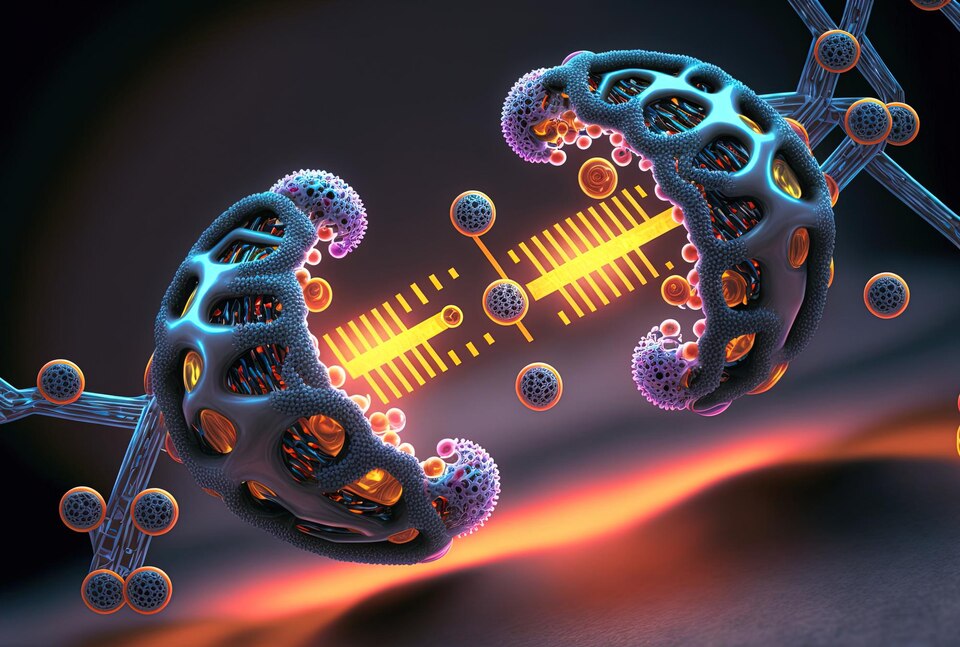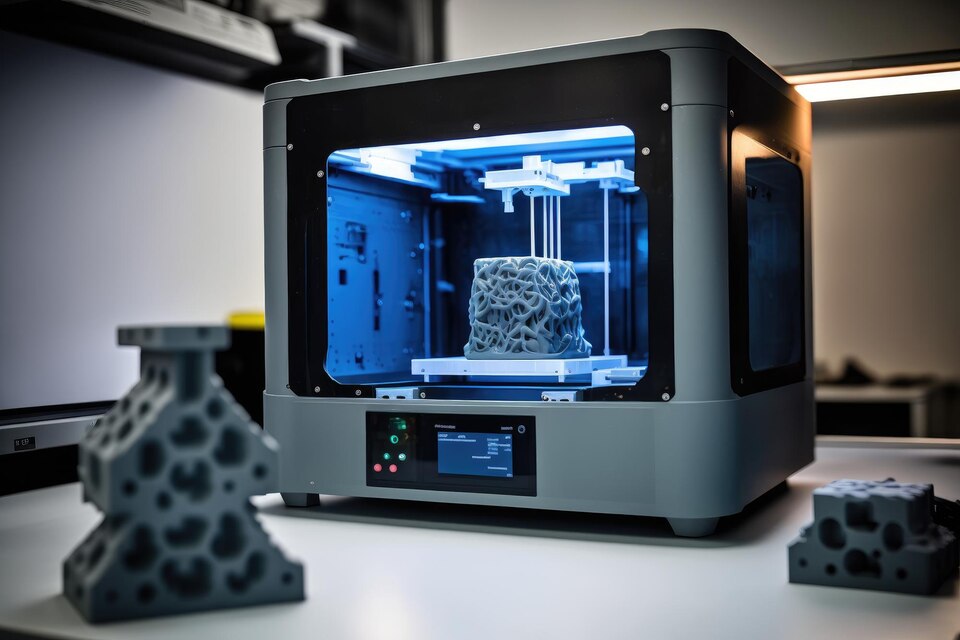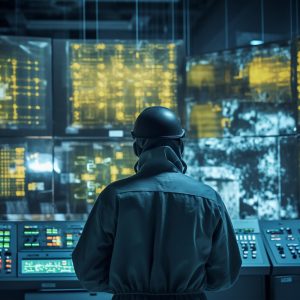The aerospace industry is experiencing a wave of transformative deep-tech trends that are revolutionizing the way we explore the skies and beyond. In this blog post, we will delve into the latest deep-tech aerospace trends that are shaping the future of aviation and space exploration.
Electric and Hybrid Propulsion Systems

Electric and hybrid propulsion systems have emerged as a transformative trend in the aerospace industry, heralding a new era of sustainable aviation. As concerns about climate change and environmental impact grow, the aviation sector is under increasing pressure to reduce its carbon footprint. In response, engineers and researchers have been diligently working on developing propulsion systems that offer cleaner and more efficient alternatives to traditional combustion engines.
Electric aircraft, powered by electricity stored in batteries, have gained significant attention and momentum in recent years. These aircraft offer several key advantages over their conventional counterparts. Firstly, they generate significantly lower emissions, leading to a substantial reduction in greenhouse gas emissions and local air pollution. By eliminating or greatly reducing the reliance on fossil fuels, electric aircraft have the potential to contribute significantly to mitigating climate change and improving air quality.
In addition to environmental benefits, electric aircraft also promise lower noise levels. Electric propulsion systems produce considerably less noise compared to traditional engines, resulting in quieter takeoffs, landings, and overall flight operations. This reduction in noise pollution opens up the possibility of expanding airport operations to urban areas and mitigating the impact of aircraft noise on surrounding communities.
Advancements in battery technology have played a crucial role in the development of electric aviation. High-capacity and lightweight lithium-ion batteries, coupled with efficient electric powertrains, are now capable of powering aircraft for extended durations. This has led to the emergence of electric vertical takeoff and landing (eVTOL) aircraft, which hold promise for urban air mobility and the future of air transportation. eVTOL aircraft, often designed with multiple electric motors or hybrid-electric systems, offer the potential for quiet, efficient, and on-demand aerial transportation within urban environments.
While electric propulsion is gaining significant traction, hybrid propulsion systems are also being explored as an intermediate step towards full electrification. Hybrid systems combine traditional combustion engines with electric motors and energy storage, offering improved fuel efficiency and reduced emissions. They can leverage the benefits of electric power for takeoff and climb phases, where high power demand is required while relying on conventional engines for cruise and long-range operations. This hybrid approach provides a transitional solution, allowing for immediate improvements in efficiency and emissions without requiring a complete overhaul of existing aircraft fleets.
The widespread adoption of electric and hybrid propulsion systems, however, is not without its challenges. One of the primary obstacles is the limited energy density and weight of current battery technologies. As aviation demands long-range capabilities and high power-to-weight ratios, further advancements in battery technology are necessary to overcome these limitations. Researchers are actively working on developing next-generation batteries, such as solid-state and lithium-air batteries, that offer higher energy densities and improved safety profiles.
Infrastructure development is another critical aspect that needs attention. Establishing a network of charging or refuelling stations capable of supporting electric and hybrid aircraft operations will be essential for widespread adoption. Investments in infrastructure, including charging infrastructure at airports and heliports, will be crucial to ensure the practicality and viability of electric aviation.
Despite the challenges, the future of electric and hybrid propulsion systems in aviation appears promising. As technology continues to advance, we can expect to see increased adoption of electric aircraft, particularly in shorter-range and regional operations. The development of hybrid systems will provide a bridge towards fully electric aviation, allowing for incremental improvements in efficiency and emissions reduction. Ultimately, these sustainable propulsion systems have the potential to reshape the aviation industry, making air travel greener, quieter, and more sustainable.
Autonomous Systems and Artificial Intelligence

Autonomous systems and artificial intelligence (AI) have become transformative forces in the aerospace industry, reshaping the way aircraft operate and perform. The integration of AI algorithms and autonomous features into aerospace systems has brought about significant advancements in navigation, safety, efficiency, and decision-making capabilities.
One of the key applications of AI in aerospace is in-flight systems. AI algorithms are utilized to process vast amounts of data from various sensors and sources, enabling aircraft to make real-time decisions and adjustments. This includes tasks such as autonomous navigation, weather prediction, and collision avoidance. By leveraging AI, aircraft can analyze complex environmental factors, optimize flight paths, and make adjustments to ensure safe and efficient operations. These AI-powered in-flight systems not only enhance aircraft performance but also reduce the workload on pilots, allowing them to focus on critical decision-making tasks.
Unmanned aerial vehicles (UAVs) are particularly benefiting from autonomous features enabled by AI. UAVs equipped with advanced AI capabilities can perform complex missions with minimal human intervention. They can autonomously take off, fly predetermined routes, collect data, and perform designated tasks. This level of autonomy is especially valuable in scenarios that are too dangerous or impractical for human operators, such as disaster response, search and rescue operations, and aerial inspections of hazardous environments. Autonomous UAVs enable the execution of these missions with precision, efficiency, and reduced risk to human lives.
AI is also making a significant impact on aircraft maintenance and operations. By analyzing vast amounts of data collected from sensors and systems onboard an aircraft, AI-powered predictive maintenance algorithms can identify potential issues before they escalate into critical failures. This enables proactive maintenance planning, reducing downtime and optimizing the efficiency of aircraft operations. AI can also facilitate intelligent decision-making in maintenance operations by analyzing historical data, identifying patterns, and recommending optimal maintenance strategies.
Data analysis plays a vital role in the optimization of aircraft operations and safety. AI algorithms can process large volumes of data generated during flight, such as flight parameters, sensor readings, and operational performance metrics. By analyzing this data, AI systems can identify trends, anomalies, and areas for improvement. This enables airlines and operators to make data-driven decisions, optimize fuel consumption, enhance operational efficiency, and improve safety protocols.
As technology continues to advance, the future holds even more sophisticated autonomous aerospace systems. AI algorithms are becoming more capable of handling complex scenarios and adapting to dynamic environments. Machine learning techniques allow systems to continuously learn and improve their performance through experience, enabling them to make more accurate predictions and decisions over time. This opens up possibilities for autonomous systems that can handle even more challenging tasks, such as air traffic control, aerial refuelling, and formation flying.
However, the adoption of autonomous systems in aerospace does come with challenges. Safety, reliability, and regulatory compliance are of paramount importance in the aviation industry. Ensuring that autonomous systems meet rigorous safety standards and operate within regulatory frameworks is essential. Establishing robust fail-safe mechanisms, redundancy systems, and comprehensive testing protocols is crucial to building trust in autonomous aerospace systems.
In conclusion, autonomous systems and AI are revolutionizing aerospace operations, enabling aircraft to navigate, perform tasks, and make decisions with greater efficiency, safety, and precision. From in-flight systems to UAV operations, AI algorithms are enhancing aircraft performance, optimizing maintenance, and improving operational decision-making. As AI technology continues to advance, we can expect to witness even more sophisticated autonomous aerospace systems that will shape the future of aviation. By leveraging the power of AI, the aerospace industry is poised to achieve new levels of efficiency, safety, and operational excellence.
Additive Manufacturing and 3D Printing

Additive manufacturing, or 3D printing, has emerged as a groundbreaking technology in the aerospace industry, transforming the way aircraft components and structures are manufactured. With its ability to build intricate and complex geometries layer by layer, 3D printing offers unprecedented design freedom and manufacturing flexibility.
One of the significant advantages of additive manufacturing is its capacity for rapid prototyping. Traditional manufacturing methods often involve lengthy and costly tooling processes, making it challenging to iterate and refine designs quickly. However, 3D printing allows for the production of prototypes directly from digital designs, eliminating the need for specialized tooling. This accelerates the product development cycle and enables engineers to test and validate designs more efficiently, leading to faster innovation and time-to-market.
Moreover, additive manufacturing enables customization and personalization on a level not previously achievable. Aircraft components can be tailored to specific requirements, whether it’s optimizing for weight, strength, or other performance characteristics. This level of customization allows for the creation of highly efficient and optimized parts, leading to improved overall aircraft performance.
The aerospace industry has also recognized the potential of 3D printing in reducing material waste. Traditional manufacturing methods often involve subtractive processes, where excess material is removed from a larger block or sheet. This results in a significant amount of material wastage. In contrast, additive manufacturing is an additive process, meaning that material is only used where it is needed, minimizing waste and optimizing material utilization. The ability to build lightweight structures with internal lattices and optimized geometries further enhances material efficiency, leading to lighter aircraft and reduced fuel consumption.
Additionally, 3D printing offers the opportunity for design optimization. Traditional manufacturing techniques often impose limitations on the design due to constraints in manufacturing processes. However, with additive manufacturing, complex and organic shapes can be created, enabling engineers to explore innovative designs that were previously unattainable. By removing manufacturing constraints, 3D printing facilitates the production of lightweight structures with enhanced performance characteristics, such as improved aerodynamics and increased strength-to-weight ratios.
As technology continues to advance, additive manufacturing is finding applications in the production of critical aircraft components. Some companies have already successfully printed fuel nozzles, turbine blades, and other complex engine parts using additive manufacturing techniques. These advancements are not only streamlining the manufacturing process but also enabling the creation of components with enhanced performance, durability, and reliability.
However, challenges remain in fully adopting additive manufacturing for aerospace applications. Ensuring the quality and consistency of 3D-printed parts is of utmost importance, as these components are subject to rigorous safety and regulatory requirements. Efforts are underway to develop robust quality control processes and standards to ensure the reliability and integrity of additive-manufactured parts.
Furthermore, the scalability of 3D printing for large-scale production is still being explored. While additive manufacturing has proven effective for small-batch and customized production, challenges arise when attempting to manufacture complex, large-scale structures economically. However, ongoing research and development efforts are focused on addressing these challenges and optimizing the scalability of additive manufacturing for the aerospace industry.
In conclusion, additive manufacturing and 3D printing are revolutionizing aerospace manufacturing by enabling rapid prototyping, customization, and cost-effective production of complex components with optimized designs. The technology’s ability to reduce material waste, enhance design freedom, and improve overall aircraft performance makes it a transformative force in the industry. As additive manufacturing continues to evolve and mature, it holds the potential to reshape the way aircraft are designed, manufactured, and maintained, leading to more efficient and sustainable aviation.
Space Tourism and Commercial Spaceflight

Space tourism and commercial spaceflight are at the forefront of the deep-tech revolution, bringing the dream of space exploration closer to reality for civilians. Previously limited to government agencies and a select few astronauts, space travel is now being pursued by private companies investing in cutting-edge technology and infrastructure.
One of the driving forces behind the rise of space tourism is the development of reusable spacecraft. Traditional space missions have often relied on disposable rockets that were only used once, resulting in significant costs and resource inefficiency. However, private companies like SpaceX and Blue Origin have made significant strides in developing reusable rockets, such as the Falcon 9 and the New Shepard. These reusable spacecraft significantly reduce the cost of launching payloads and passengers into space, making space tourism a viable and economically feasible venture.
Advancements in spacecraft design have also played a crucial role in enabling space tourism. Private companies are focusing on creating spacecraft that prioritize passenger comfort and safety while providing awe-inspiring views of Earth and the cosmos. These spacecraft are equipped with large windows, allowing passengers to experience the breathtaking sights of space. Comfortable seating, life support systems, and safety measures are also incorporated to ensure a smooth and enjoyable journey for space tourists.
Launch systems are another area where significant progress has been made. Traditional rocket launches have primarily taken place from government-operated facilities, limiting access to space. However, private companies are now developing their launch systems and facilities, expanding the opportunities for commercial spaceflight. Launch sites like SpaceX’s Cape Canaveral and Blue Origin’s West Texas launch site are facilitating more frequent launches and reducing dependence on government infrastructure.
The growth of space tourism is not just limited to joyrides in space. Private companies are also exploring the potential for long-duration spaceflights and space hotels. Companies like Axiom Space have plans to build commercial space stations that can accommodate tourists for extended stays in orbit. This development could open up possibilities for space vacations, research opportunities, and scientific collaborations outside the confines of traditional government-run space agencies.
The rise of space tourism and commercial spaceflight has broader implications for the future of space exploration. It not only enables civilians to experience the wonders of space but also generates revenue and fosters technological advancements that can benefit space science and research. Private companies are investing in innovations like asteroid mining, lunar exploration, and deep space missions, pushing the boundaries of human knowledge and paving the way for potential space colonies and scientific discoveries.
However, the development of space tourism and commercial spaceflight does come with challenges. Safety and regulatory concerns are of paramount importance, as space travel involves inherent risks. Ensuring the safety of passengers and addressing potential hazards associated with spaceflight are critical considerations. Regulatory frameworks need to be established to govern commercial space activities and ensure responsible and sustainable practices.
Despite the challenges, the future of space tourism and commercial spaceflight looks promising. The combined efforts of private companies, government agencies, and advancements in technology are driving the industry forward. As costs decrease, technology improves, and infrastructure expands, space tourism will likely become more accessible and affordable for a broader range of individuals. This, in turn, will drive further innovation, foster space exploration, and ignite a new era of human presence and activities in space.
In conclusion, space tourism and commercial spaceflight are becoming a reality, thanks to the deep-tech revolution. Private companies are investing in reusable spacecraft, spacecraft design, and launch systems to make space travel more accessible and economically viable. These developments not only enable civilians to experience space but also hold the potential for scientific advancements, space research collaborations, and the eventual establishment of space colonies. As the industry continues to evolve, the future of space tourism looks promising, heralding a new era of human space exploration and discoveries.
Satellite Constellations and Global Connectivity

Satellite constellations are revolutionizing global connectivity by addressing the digital divide and transforming communication infrastructure. Traditionally, providing internet access to remote regions and underserved areas has been a challenge due to the limitations of terrestrial networks. However, the deployment of satellite constellations consisting of numerous small satellites in low Earth orbit (LEO) is changing the game.
The primary objective of satellite constellations is to offer broadband internet access to even the most remote corners of the world. Companies such as SpaceX’s Starlink, OneWeb, and Amazon’s Project Kuiper are leading the way by launching thousands of small satellites into LEO. These satellites work in coordination, forming a network that blankets the Earth, enabling high-speed, low-latency internet connectivity to previously inaccessible areas.
The use of LEO is a crucial element in satellite constellations’ success. Compared to traditional geostationary satellites located at a much higher orbit, LEO satellites are much closer to the Earth. This proximity significantly reduces the signal latency, resulting in improved internet performance and user experience. Users in remote regions can now enjoy faster browsing, seamless video streaming, and enhanced online communication thanks to the low-latency connectivity provided by satellite constellations.
The advanced communication technologies employed in satellite constellations play a crucial role in their effectiveness. These constellations rely on sophisticated antenna systems and beamforming technologies that allow for efficient communication between the satellites and ground stations. These technologies enable the satellites to establish dynamic connections, optimize signal strength, and adapt to varying network demands, ensuring consistent and reliable internet connectivity across the entire coverage area.
The impact of satellite constellations on bridging the digital divide cannot be overstated. By extending internet access to underserved areas, these constellations have the potential to connect millions of people who were previously isolated from the digital world. This connectivity unlocks opportunities for education, e-commerce, telemedicine, and communication, empowering individuals and communities and driving economic growth.
Furthermore, satellite constellations offer resilience and redundancy in communication infrastructure. Traditional terrestrial networks can be vulnerable to natural disasters, infrastructure damage, or connectivity disruptions. Satellite constellations, with their global coverage and distributed network, provide an alternative and backup communication system that can quickly restore connectivity in the face of such challenges. This resilience is particularly valuable in remote or disaster-prone regions where maintaining reliable communication is critical for emergency response and disaster management.
However, the deployment of satellite constellations is not without its challenges. One significant concern is space debris and the potential for collisions in crowded LEO environments. As the number of satellites increases, so does the need for responsible space debris mitigation strategies. Satellite operators are actively working on implementing measures such as deorbiting plans, collision avoidance systems, and satellite design considerations to minimize space debris risks and ensure the long-term sustainability of LEO.
Another consideration is the regulatory framework surrounding satellite constellations. As the number of satellites and their impact on Earth’s orbit increase, governments and international bodies are working to establish guidelines for satellite deployments, spectrum allocation, and interference mitigation. These regulations aim to ensure fair access to orbital slots, prevent overcrowding, and address potential interference issues with other satellite systems or astronomical observations.
In conclusion, satellite constellations are transforming global connectivity by providing broadband internet access to remote regions and underserved areas worldwide. With their advanced communication technologies, LEO deployments, and low-latency connectivity, these constellations have the potential to bridge the digital divide and revolutionize communication infrastructure on a global scale. As satellite constellations continue to evolve and expand, they hold the promise of a more connected world, unlocking opportunities for education, economic development, and improved quality of life.
Conclusion
The deep-tech aerospace trends discussed above are not only individual advancements in their respective fields but also interconnected elements that are shaping the future of aviation and space exploration as a whole. Each trend brings unique benefits and contributes to a broader vision of a more sustainable, efficient, connected, and accessible aerospace industry.
Electric and hybrid propulsion systems are paving the way for a greener and more environmentally friendly aviation sector. With reduced emissions, lower noise levels, and increased energy efficiency, electric aircraft offer a promising solution to mitigate the environmental impact of traditional combustion engines. Advancements in battery technology and electric powertrains are continuously improving the range, power, and reliability of these systems. As battery technology evolves, we can expect even longer flight durations and the emergence of electric vertical takeoff and landing (eVTOL) aircraft, revolutionizing urban air mobility and short-distance travel.
Autonomous systems and artificial intelligence (AI) are reshaping aerospace operations, enhancing safety, efficiency, and decision-making capabilities. AI algorithms integrated into in-flight systems enable real-time data processing, improving navigation, weather prediction, and collision avoidance. Unmanned aerial vehicles (UAVs) equipped with autonomous features can perform complex missions with minimal human intervention, expanding the possibilities for applications such as disaster response, aerial inspections, and scientific research. AI also plays a crucial role in aircraft maintenance, predictive maintenance algorithms, and data analysis, optimizing operational efficiency and reducing downtime.
Additive manufacturing, or 3D printing, is transforming aerospace manufacturing by enabling the production of intricate and lightweight components with complex geometries. This technology allows for rapid prototyping, customization, and cost-effective production of aircraft parts. By reducing lead times, material waste, and assembly complexity, additive manufacturing revolutionizes supply chains and improves efficiency. It also facilitates design optimization, leading to the creation of lightweight structures and fuel-efficient aircraft. As materials and printing techniques advance, we can expect even greater integration of 3D-printed components in aerospace manufacturing.
Space tourism and commercial spaceflight are democratizing access to space, making it possible for civilians to experience the wonders of space travel. Private companies are investing in reusable spacecraft and infrastructure to reduce the cost of launches and increase the frequency of space missions. These developments not only open up new opportunities for space tourism but also foster advancements in space science, research, and exploration. Commercial space stations, lunar missions, and deep space exploration are all within reach, driving innovation and expanding our understanding of the universe.
Satellite constellations are revolutionizing global connectivity by providing broadband internet access to remote and underserved areas worldwide. The deployment of large networks of small satellites in low Earth orbit (LEO) ensures high-speed, low-latency internet connectivity on a global scale. This technology bridges the digital divide, connecting millions of people to the digital world and unlocking opportunities for education, e-commerce, telemedicine, and communication. The advanced communication technologies employed in satellite constellations, coupled with LEO deployments, offer resilience and redundancy in communication infrastructure, making it more robust and reliable.
The convergence and integration of these deep-tech aerospace trends are driving the industry forward, creating synergistic effects and unlocking new possibilities. For example, electric and hybrid propulsion systems can be combined with autonomous capabilities to create efficient and sustainable unmanned aircraft. Additive manufacturing techniques can be employed to produce lightweight components for space tourism spacecraft. AI algorithms can enhance the performance and safety of satellite constellations by optimizing communication networks and predicting maintenance requirements. The possibilities for innovation and cross-pollination are immense, propelling the aerospace industry toward new frontiers.
In conclusion, the deep-tech aerospace trends discussed above represent the cutting-edge advancements that are shaping the future of aviation and space exploration. Electric and hybrid propulsion systems, autonomous systems and AI, additive manufacturing, space tourism, and satellite constellations are driving the industry











